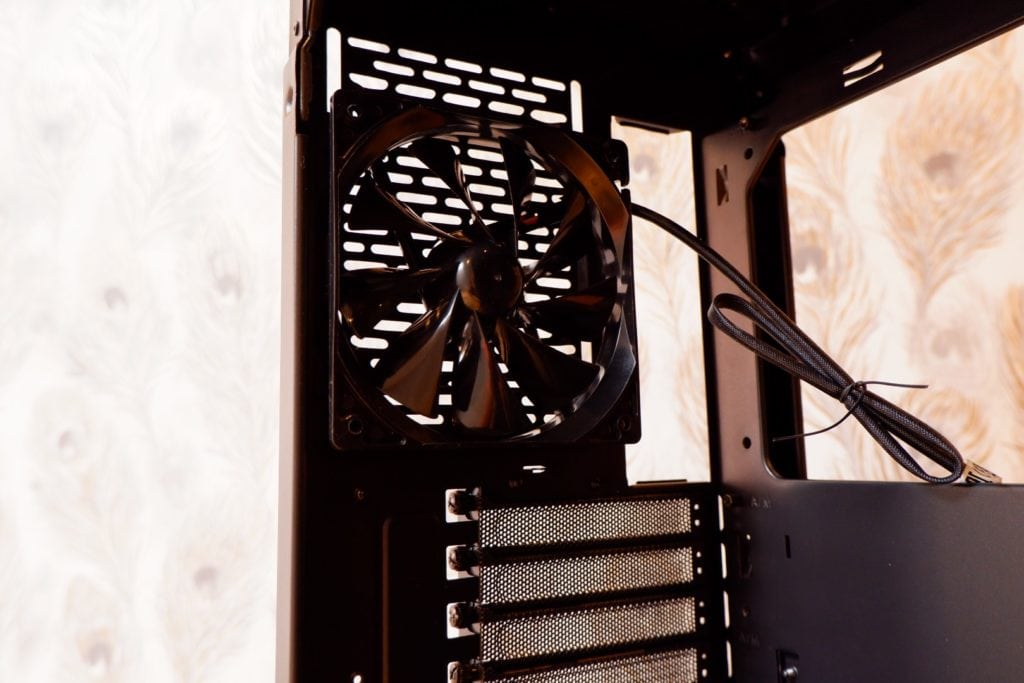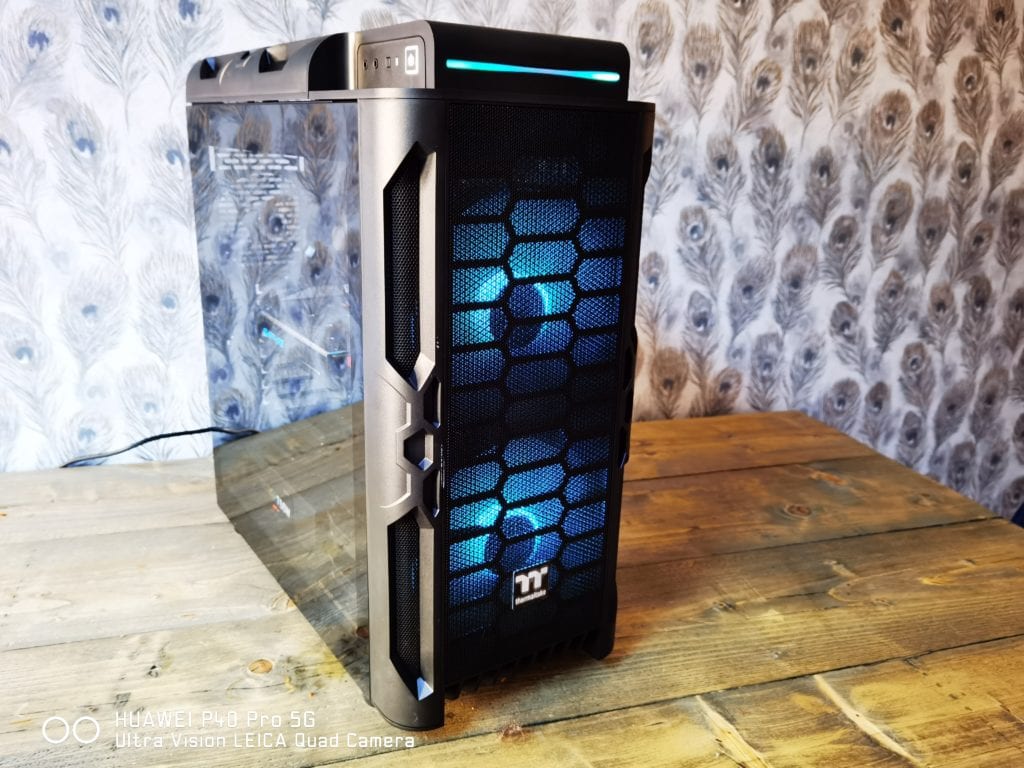I reviewed the original Thermaltake Level 20 GT back in 2018, then the ARGB model in 2019, and I still use the original case for my work PC. If you like (really) big cases, RGB, and tempered glass, they are awesome being able to comfortably able to accommodate the most extravagant of system.
The downside is that they are quite expensive, with the Level 20 GT currently selling for £214.99 on Scan.
Thermaltake have now introduced a more affordable variant of this which provides a slightly different aesthetic and more importantly provides a significant drop in price, down to £154.99.
Thermaltake Level 20 RS vs Level 20 GT ARGB
At first, I thought this was the exact same frame as the GT models, but it is a slightly more manageable size being classed as a mid-tower with dimensions of 524 x 240.8 x 553 mm and a total weight of 12.23 kg
In comparison, the GT has dimensions of 580 x 294 x 592 mm with a weight of 19.1 kg.
So you lose quite a bit of internal space, but a lot more convenient to place on a desk or the floor.
As a result of the larger internal space the Level 20 GT can accommodate up to E-ATX motherboards whereas the RS is limited to the more common ATX.
Fans
As for cooling this comes with two 200mm ARGB fans running at a fixed 600rpm with a noise of 29.2dBA.
On the rear, you get one 120mm fan running at 1000rpm with a noise rating of 16 dBA
The ARGB model of the GT series has the same front fan configuration, but on the rear, this accommodates a larger 140mm
They both have the same front fan options too, with up to 3x120mm, 3x140mm or 2x200mm
On the top the RS series takes 3 x 120mm, 2 x 140mm, 1 x 200mm, the GT series can squeeze in 3×140 or 2x200mm
For the rear the RS can only handle 120mm while the GT can do 140mm.
The RS series has no bottom fan support while the GT can hand 2x120mm
Radiators
For the RS you get:
- Front: 1 x 280mm, 1 x 360mm
- Top: 1 x 280mm, 1 x 360mm
- Rear: 1 x 120mm
- Right: 1 x 360mm (Without HDD Rack)
For the GT you get:
- Front: 1 x 360mm, 1 x 420mm, 1 x 360mm(For 200mm fan)
- Top: 1 x 360mm, 1 x 360mm(For 200mm fan)
- Rear: 1 x 120mm, 1 x 140mm
- Right: 1 x 360mm, 1 x 420mm (AIO: 1 x360mm, 1 x 280mm)
- Bottom: 1 x 240mm
So this is the big area where you make a compromise. Massive water-cooled systems may be better off in the GT, but you average person using an AIO cooler that top out at 360mm will easily fit their hardware into the RS.
Glass Panels & Airflow
Part of the reason the Level 20 GT costs a lot is the four 5mm tempered glass panels on the front, top and the two sides, which are also hinged.
With the RS you get two slide on 4mm panels. It makes it less convenient if you open up your case a lot, but once the PC is built you cant really tell the difference between a 4mm slide on panel and a 5mm hinged.
Technically, the RS should have better airflow, the GT glass panels on the front and top will likely restrict airflow slightly. They are raised away from the fans with air gaps on the bottom and side, so it shouldn’t make a huge differecnce, I certainly haven’t noticed, but high performance systems may appreciate a bit more airflow.
Storage
Both cases have the same storage specifications, and they both have 8 expansions slots.
- 2.5” x 4 or 3.5” x 4 (HDD Rack)
- 2.5” x 4 or 3.5” x 2 (HDD Bracket)
- 2.5” x 2 or 3.5” x 1 (Without HDD Rack)
Build
During the build, I had a small issue with the PSU cover. Aesthetically it is great, but it adds time to the build with the covering being on both sides, and the cover screwed down into place with quite tight screws. Unless you remove the cover, it is a little awkward running everything through, especially, if, like me, you plugged in the power to the motherboard first then tried plugging the modular cable into the PSU.
Apart from that everything ran smoothly, due to the current issues with everyone working from home, some of my components were taken up by my partner after I quickly assembled a PC for her. So I was unable to install a decent AIO cooler.
Similar to the other high-end cases from Thermaltake, there are mounting options all over the place, in the front of the case you get 2x SSD mounts plus the 3.5 cages, or if you prefer, you can then hide your SSD on the other side.
Like other cases for the GPU, you have options to mount it or opt for a traditional placement vertically.
Like other ARGB products from Thermaltake, you can manually switch between lighting modes.
Cables are pretidied for you, and there three large cable routing cut-outs as well as a large CPU cutout, so you shouldn’t have too many issues making your build tidy.
Price and Competition
Overclockers have this case listed at £154.99 with other options around that price in the mid-tower format including
- Thermaltake View 37 ARGB – £160
- Fractal Define 7 – £155
- NZXT H510 – £150
- Corsair Obsidian 500D – £150
All excellent options but I would argue the Level 20 RS has the slight edge for cooling with the 200mm fans, and either this or the Fractal has the best radiator support. This goes up to 3x360mm the Fractal can only accommodate 2x360mm, but the top panel goes up to 420mm.
Overall
If you wanted a Level 20 GT but didn’t have a system enough big or expensive enough to justify it, the new Level 20 RS could very well be the case for you.
For modders, like most Thermaltake cases, this is perfect, allowing to strip it down completely removing anything redundant.
It comes with impressive cooling out of the box, the two 200mm fans and mesh panel front should provide superior airflow compared to many other cases on the market. The fixed RPM fans may not be to the liking of quiet PC enthusiast.
Overall this is a superb case that is a bit more sensible for your average PC build than the GT and from what I can tell it offers a superior specification to competing models at the same price point.













